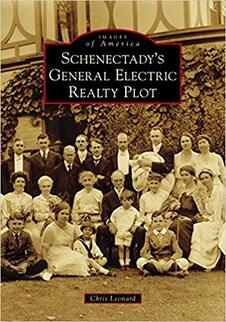 So it's been a while since I wrote in this blog, more than a year in fact. The problem with keeping a blog is that it is a whole lot like work. But I’m going to try to be better. As Schenectady City Historian, I use my Twitter Feed to present important happenings in the city and to engage with the public, but 256 words is sometimes not enough to discuss complex historic issues and happenings. My plan is to provide an entry here every other week to let you know what I’m working on, what we’re doing in the Efner History Center in the Attic of Schenectady City Hall, and keep you up to date with important happenings in Schenectady and the Mohawk Valley. So let’s start with me. What have I been doing in 2019? First and foremost, my first book Schenectady’s General Electric Realty Plot was published on April 29 by Arcadia Publishing Company as part of their Images of America line. From the book jacket: "Schenectady’s General Electric Realty Plot was formed in 1899 when the General Electric (GE) Company purchased 70 acres of land from Union College to provide unique housing opportunities for its executives and scientists and to attract brilliant minds from around the world to work for GE. The original 178 homes were designed by leading architects from as far away as Boston, New York City, and Chicago. The neighborhood, colloquially known as “The Plot,” would also become home to political and religious leaders, businesspeople, and entertainment elite. Inhabited by luminaries such as Charles Proteus Steinmetz, 1932 Nobel Prize winner Irving Langmuir, Ernst Alexanderson, and William D. Coolidge, the GE Realty Plot was also home to many important historic firsts, including the first demonstration of radar in the United States and the first reception of a television signal in a house." The project was a twelve month labor of love about a neighborhood that is very dear to my heart and of great historic significance to Schenectady. It is available from: Amazon.com , Open Door Bookstore, Schenectady County Historical Society, Marty's True Value, directly from the author, and other upstate bookstores. I was also engaged by the Colonial Schenectady Project to edit the second volume of Schenectady Genesis, by John Gearing. This work is a follow-up to Susan Staffa's groundbreaking Schenectady Genesis: How a Dutch Colonial Village Became an American City, ca. 1661-1800. Mr. Gearing's excellent manuscript covers from 1760-1798, possibly the most tumultuous period in the history of the city. The work highs Schenectady's role in the American Revolution, its development as an early economic powerhouse because of the beaver trade, the decades long battle for the Common Lands that nearly destroyed the city, and the drive to gain independence from Albany by acquiring a charter. Look for Schenectady Genesis, Volume II in late Summer 2020 from SUNY Press. Next time, I'll delve into the projects we're tackling at the Efner History Center. |
City Historian of SchenectadyArchivesCategories
All
|
 RSS Feed
RSS Feed
